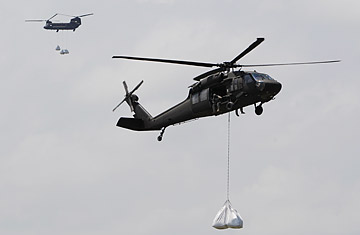
National Guard helicopters drop 2,000-lb. bags of sand in an effort to protect Scofield Bay from the Deepwater Horizon oil spill near Venice, La.
As BP's efforts to plug the oil leak in the Gulf of Mexico have floundered in recent weeks, there has been a mounting clamor for the U.S. military to do something. Over the June 12-13 weekend, a former Navy submariner urged that the leak be attacked with conventional explosives to seal it. Last week, a scientist who has worked for the Marines made a similar argument, suggesting the detonation of a 4-ton bomb just above the leak to snuff it out. But advocates of a military solution may want to consider the forces' recent records in underwater and leaking-fuel cleanups first.
Last week the Navy lost four of its 13 unmanned underwater vehicles during a mine-hunting exercise at the mouth of the Chesapeake Bay. After fruitless days of searching for them from boats and planes, the Navy has turned to dolphins and sea lions to aid in the hunt for the 5-ft.-long, 80-lb., sonar-outfitted submersibles. "Go Flipper!" the Fredericksburg Free Lance-Star newspaper editorialized. In fact, a dolphin did recover one of the vehicles before the Navy abandoned the search Monday.
Just as disconcerting is the Air Force's handling of a fuel leak under New Mexico's Kirtland Air Force Base. A 16-in. pipe had leaked jet fuel from 1950, shortly after a bulk-fuel-storage site opened on the base, until 1999, when the leak was discovered. Just like BP, the Air Force is minimizing the leak — it maintains that between 1 million and 2 million gal. flowed from the pipe during the half-century it oozed undetected. But state environmental officials say 8 million gal. may have escaped.
While the Air Force managed to stop that leak a decade ago, the escaped jet fuel is now floating a foot thick atop Albuquerque's water table 500 ft. beneath the ground. It is moving silently and unseen from the base into city limits. It has oozed underneath a park and is traveling toward the wells that supply the city's drinking water. As the scale of the contamination became clear, the state grew frustrated by what it saw as the Air Force's foot-dragging. So it shifted state responsibility for the cleanup from New Mexico's Groundwater Quality Bureau, which carries little clout with the Feds, to its Hazardous Waste Bureau, which carries out cleanups under federal guidance.
New Mexico officials estimated the cleanup could cost $100 million and have maintained that the Air Force's original plan to clean up the spill could take 56 years. Under state and congressional pressure, the service has agreed to speed up the process. "We are working to identify the best technology to clean up the contamination as quickly as possible," Air Force environmental chief Terry Yonkers pledged to lawmakers. But the Air Force, apparently channeling its inner BP, pledged only $15 million to accelerate the effort, at least for this year. And, also echoing the oil company, the Air Force's first mission is to figure out just how much fuel leaked. Of course there's one big difference: U.S. taxpayers will pay to clean up the Air Force leak.
